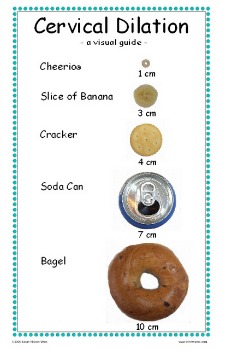Your Guide to Cervix Dilation
The Skinny On Dilation
I like to think of cervix dilation like opening the door to the womb to allow baby to come out. Normally, your cervix is closed and hard, protecting your uterus from the outside environment.
In order for your baby to pass through, your cervix must dilate and thin out completely.
Here's A Rundown of What Happens From "0 cm" to Complete Cervix Dilation...
Before labor, your cervix is firm, kind of like the tip of your nose. It’s closed and points toward the back of your vaginal wall. As your body prepares for labor, a few things happen:
- Your cervix will start to move forward until it's tilted toward the front of your vaginal wall.
- It gets really soft and starts to dilate, or open up.
- It also thins out, which is called cervical effacement.
What Causes Cervical Dilation?
At the end of pregnancy, when the baby drops down into the pelvis, the baby’s head puts pressure on the cervix. This constant pressure causes your body to release oxytocin, which is the hormone that causes contractions.
The contractions push the baby even farther down onto the cervix, which causes it to dilate, which causes more contractions and so on…. It’s the combination of hormones and pressure from the baby’s head that cause cervix dilation.
How Cervix Dilation is Measured
Dilation of the cervix is measured in centimeters. During labor, your cervix will stretch from 0cm to a fully dilated 10 cm.
During a vaginal exam, cervix dilation is
measured by how many finger widths fit into the opening of the cervix.
If the tip of one finger fits, the cervix is 1 cm dilated. If 2 finger
tips fit, that signifies 2 cm. The distance the two fingers can stretch
wide indicates further dilation.
Does It Mean I'm Going Into Labor?
Nope, sorry. Dilation doesn’t tell you when you’ll go into labor, or how fast your labor will be. Believe it or not, you can be dilated to a few cm for a few weeks before you go into labor.
On the flip side, you could have a completely closed cervix and go into labor the same day. Every labor is different.
I can't tell you how many times I hear stories about women who get a vaginal exam and end up discouraged that they aren't dilated. Or, even worse, they are dilated and get their hopes up about going into labor, only to be pregnant a few more days.
If you do decide to get a vaginal exam to find out, try not to put too much faith in the results either way :)
You can check out more accurate early labor signs here that will give you a better idea that labor is imminent.
Cervical Effacement
Your cervix also needs to thin out completely for baby to be born. Before you have your baby, your cervix is long and hard. As your body prepares for labor, it starts to soften and by the time you’re ready to push it has nearly diminished.
Cervical effacement is measured in percentage. When your cervix is 100% effaced, that means it is paper thin, so the baby can slip right through.
You can see in the diagram at the top of this page that on the left the cervix is long and progressively thins and diminishes over time.










Comments
Have your say about what you just read! Leave me a comment in the box below.